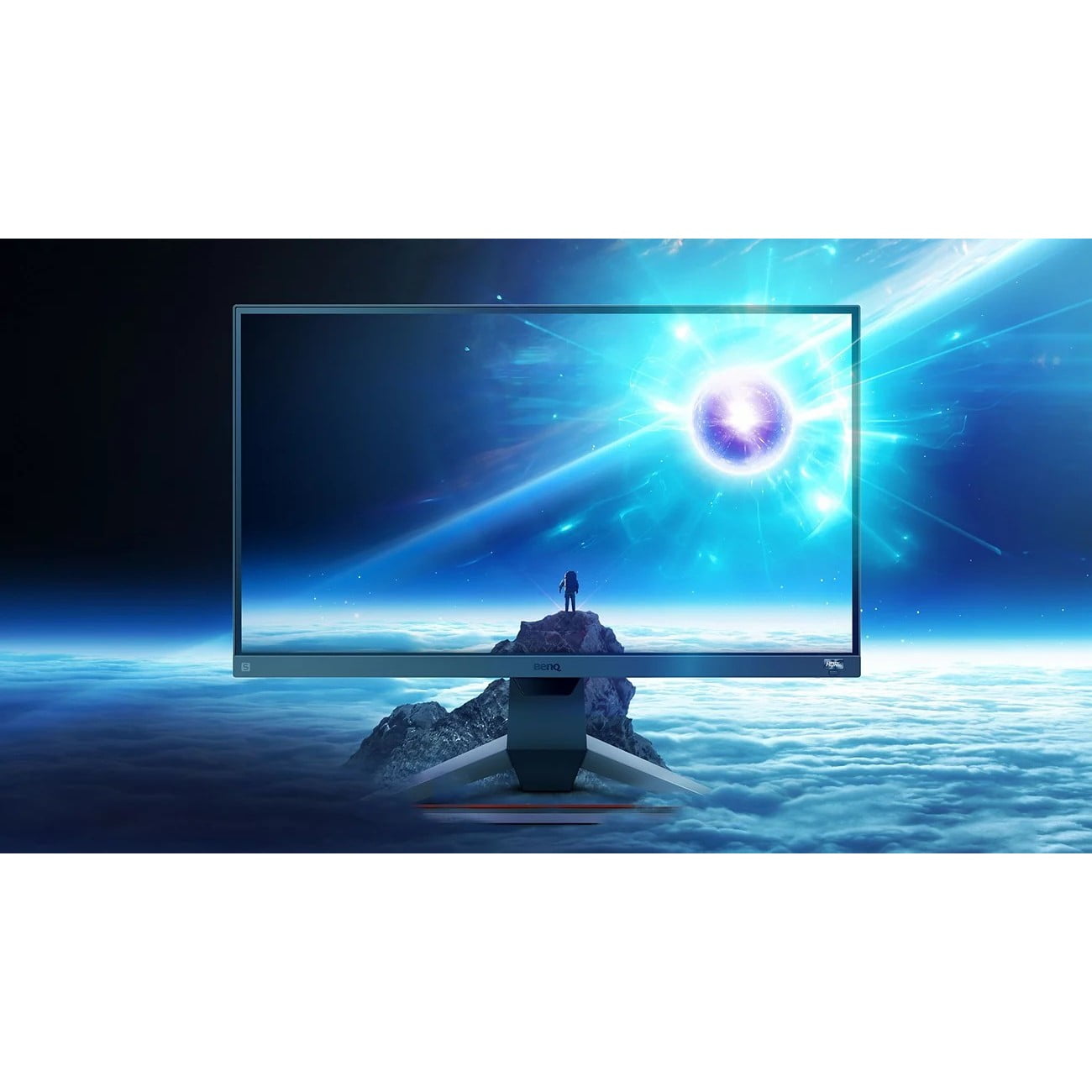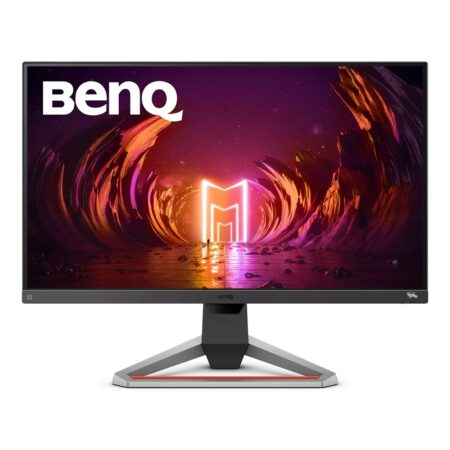CONS
- Stand and cabinet design may not be for all gamers
- No USB ports
- HDR performance is middling
BENQ MOBIUZ EX2510S SPECS
| Panel Size (Corner-to-Corner) |
24.5 inches |
| Native Resolution |
1920 by 1080 |
| Aspect Ratio |
16:9 |
When browsing for a new gaming monitor, you will find a wide selection of 1080p high-refresh options available, including BenQ’s Mobiuz EX2510S. This monitor is designed for high-performance gaming, meeting the needs of speed-focused players. However, the inclusion of HDR10 support, without the expected premium picture quality, results in unnecessary added cost. Additionally, the monitor’s flimsy stand and lack of onboard USB ports highlight areas where the budget could have been better utilized. For a slightly higher price, the MSI Oculux NXG253R offers more than double the speed and impressive image quality comparable to monitors priced much higher.
The Mobiuz Mission: Enjoy 1080p Gaming on a Fast Panel.
The Mobiuz EX2510S is a monitor that measures 24.5 inches diagonally and has a native resolution of 1,920 by 1,080 pixels. It also boasts a native refresh rate of 165Hz and is constructed with an IPS panel.
The stand of the monitor resembles that of the Mobiuz EX3415R, which we previously evaluated this year. However, gamers might not find it appealing. BenQ monitors have always prioritized performance over design, and this is evident in this model. A single orange stripe adorns the triangular plastic base of the monitor, indicating its gaming nature. Unfortunately, the stand lacks the stability we desire.
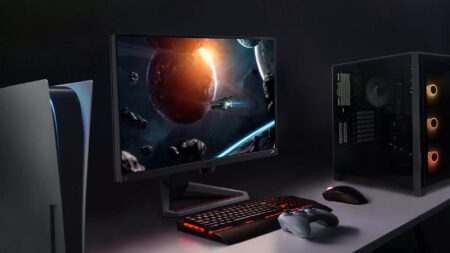
The Mobiuz cabinet distinguishes itself solely through its stripe design, compared to an office monitor. However, it offers above-average adjustability, including a vertical tilt range of -5 to 20 degrees, wide 178-degree viewing angles in both directions, and a swivel range of -20 to 20 degrees. Unfortunately, the display lacks the ability to pivot 90 degrees for landscape and portrait modes.
The Mobiuz cabinet stands out with its unique stripe design, setting it apart from typical office monitors. Despite this, it boasts exceptional adjustability features such as a vertical tilt range of -5 to 20 degrees, wide 178-degree viewing angles both horizontally and vertically, and a swivel range of -20 to 20 degrees. Regrettably, the display does not have the capability to pivot 90 degrees for landscape and portrait modes.
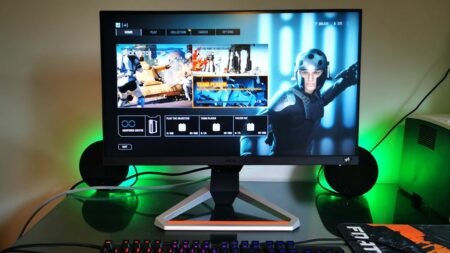
The control of BenQ’s onscreen display (OSD) menu is managed by a five-way joystick located at the rear right of the unit. It is accompanied by three additional control buttons positioned below. The OSD has been recently updated and now provides a wide range of customization options and settings. Moreover, it presents all of these features in a highly user-friendly format, making it one of the most effortlessly navigable interfaces we have encountered on a gaming display.
Pressing the joystick to the right activates a convenient “hot menu” that allows you to modify profiles, adjust brightness, and personalize settings according to your preferences. This feature enables effortless switching between different profiles and customization options. Among the many commendable aspects of this monitor, its OSD stands out as a prominent highlight.
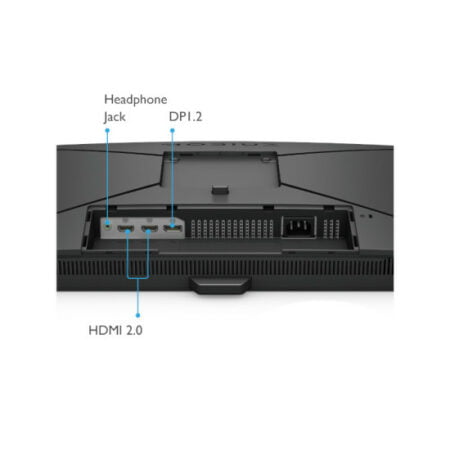
In terms of ports, the Mobiuz’s may not meet everyone’s expectations. The cabinet’s underside reveals only two HDMI 2.0 ports, along with one DisplayPort 1.4b input. Additionally, there is a 3.5mm headphone jack available for HDMI audio pass-through. However, there are no USB upstream or downstream connections present, only the essential ports.
The Mobiuz EX2510S: Excellent for Gaming, but Lacking in HDR Capabilities.
As previously stated, the 1080p screen features an IPS panel and a native refresh rate of 165Hz (without any overclocking options available). With HDR10 compatibility and support for AMD FreeSync Premium, the EX2510S was subjected to our usual gaming-monitor evaluation using a Datacolor SpyderX Elite colorimeter. Here are our findings…
Upon conducting a test on the default picture mode using an SDR signal, the BenQ exhibited a peak brightness of 288.5 nits, slightly surpassing its 280-nit specification, along with a black level of 0.33 nits. This resulted in a contrast ratio of 870:1, slightly lower than the advertised 1,000:1 ratio.

Moving on to HDR testing, we observed unexpected spikes in brightness reaching up to 406.1 nits, a benchmark that numerous HDR10 monitors strive for but only a handful achieve. However, as we will discuss further, this level of brightness did not consistently translate into the anticipated image quality one would expect from a 1080p display.
The Mobiuz EX2510S falls short in terms of sRGB and Adobe RGB gamut coverage compared to several other models we have recently tested, with percentages of just 96% and 75% respectively. Additionally, its DCI-P3 coverage is only at 79%. These numbers are notably lower than those of competing Fast IPS-based panels, making it below average for content creators in general.
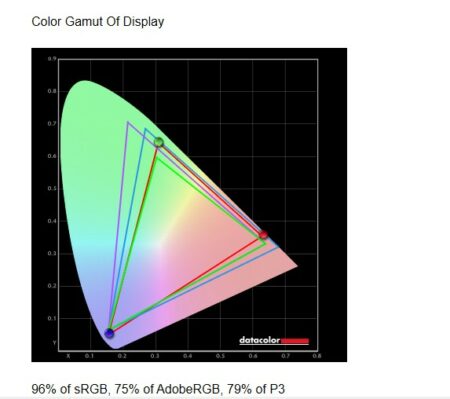
Following those findings, the Mobiuz displayed an above-average Delta E (dE) color accuracy reading of only 1.68, indicating the potential for achieving a reading below 1.0 through meticulous adjustments utilizing BenQ’s comprehensive color configuration choices.
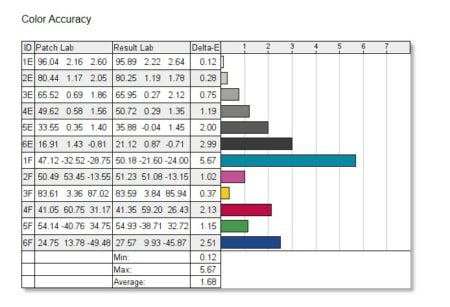
Performance in Media and Gaming.
Let’s move on from the statistics. What was the visual experience like when we started playing videos and games?
Let’s shift our focus away from the numerical data. How did the visuals appear when we launched videos and games?
Our 4K Costa Rica test footage appeared predictably subpar on an HDR10 display, even when output at 1080p to match the monitor’s native resolution. Reverting back to SDR mode only managed to elevate the quality to a mediocre level. Nevertheless, SDR mode maintained fast speeds during gaming, as HDR introduces input lag and increases response times. This monitor primarily focuses on delivering optimal gaming performance.
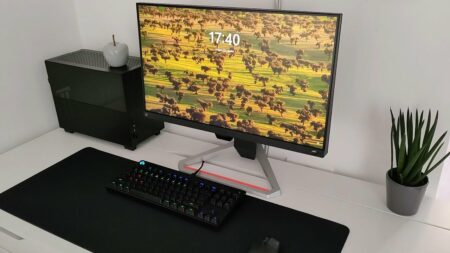
Furthermore, I proceeded to launch Red Dead Redemption 2 on my system and experimented with toggling the HDR setting on and off to observe the monitor’s performance in handling each mode. Unfortunately, the HDR picture quality was once again underwhelming, exhibiting the same problems we encountered during our previous picture testing. It seems that HDR support is occasionally included in 1080p performance monitors simply because it is possible, rather than being a necessary addition. As a result, it often appears more appealing as a marketing tactic on the packaging rather than as a noteworthy feature on the monitor itself.
To assess the conventional input lag, which refers to the time delay between when a monitor receives a signal and when the screen updates, we employ an HDFury 4K Diva HDMI matrix for testing purposes. When subjected to a 60Hz test signal, the Mobiuz is among the recent displays we have evaluated that consistently yield results below 1 millisecond. However, our detector is unable to precisely measure the exact extent of this sub-millisecond performance.
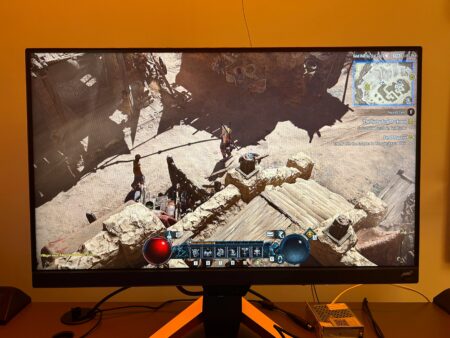
To witness the tangible effects of the minimal input lag, I decided to engage in a few sessions of Counter-Strike: Global Offensive, Valorant, and Overwatch. In each of these games, the BenQ monitor provided an exceptional gaming experience, rivaling even the top-tier high-refresh panels such as the MSI Oculux NXG253R. Interestingly, I found myself engrossed in Overwatch for a longer duration than my usual testing period. The monitor’s responsiveness was so remarkable that my performance, compared to my regular scores on my personal 200Hz monitor, actually improved slightly. This can be attributed to the heightened sense of responsiveness and speed I experienced while playing certain characters. Undoubtedly, low input lag proved to be a significant advantage!
Pros and Cons of a Mobiuz Strip.
BenQ’s most recent Mobiuz model, positioned as a midrange-priced 1080p gaming display, may be considered slightly overpriced considering its limited port options and plastic base. However, the EX2510S truly shines in the gaming scenarios it was designed for. Its impressive performance, characterized by low input lag and a highly responsive feel, resulted in significant victories both in formal testing and during our multiplayer gaming trials on our personal esports scoreboard.
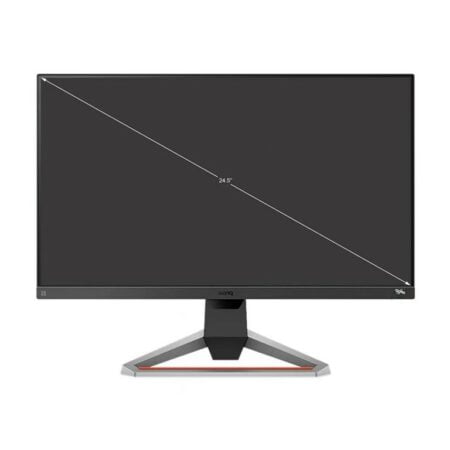
Due to the mediocre picture quality, however, the inclusion of its HDR rating seems irrelevant, and the limited brightness fails to compensate for this as a primary monitor for viewing and creating content. Consequently, the Mobiuz finds itself in a rather specific predicament, excelling in games that prioritize speed but falling short in terms of overall content enjoyment and productivity. Individuals who frequently indulge in both movie-watching and gaming may find better-suited alternatives such as the well-balanced Fast IPS-based Acer Nitro XV252Q F.

